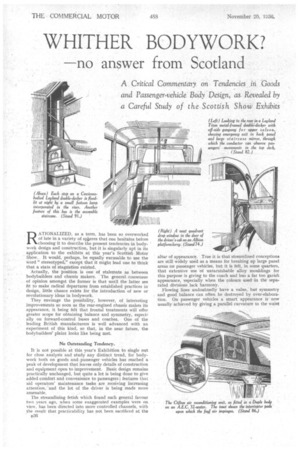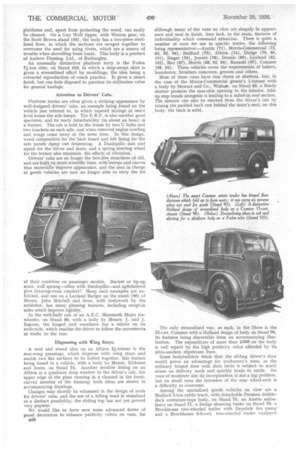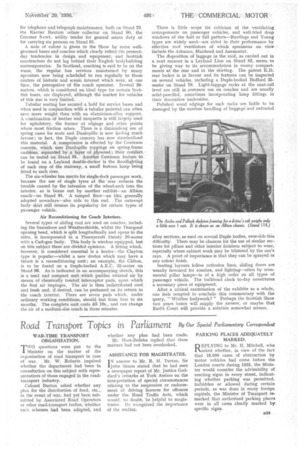WHITHER BODYWORK?
Page 50

Page 51

Page 52

Page 53

If you've noticed an error in this article please click here to report it so we can fix it.
—no answer from Scotland
A Critical Commentary on Tendencies Goods and Passenger-vehicle Body Design, asRevealed by a Careful Study of the Scottish Show Exhibits
RATIONALIZED, as a term, has been so overworked of late in a variety of spheres that one hesitates before choosing it to describe the present tendencies in bodywork design and construction, but it is singularly apt in its application to the exhibits at this year's Scottish Motor Show. It would, perhaps, be equally excusable to use the Word "stereotyped," except that it might lead one to think that a state of stagnation existed.
Actually, the position is one of stalemate as between bodybuilders and chassis makers. The general consensus of opinion amongst the former is that until the latter see fit to make radical departures from established practices in design, little chance exists for the introduction of new or revolutionary ideas in bodywork.
They envisage the possibility, however, of interesting improvements so soon as the rear-engined chassis makes its appearance, it being felt that frontal treatments will offer greater scope for obtaining balance and symmetry, especi: ally on forward-control buses and coaches. One of the leading British manufacturers is well advanced with an experiment of this kind, so that, in the near future, the bodybuilders' plaint looks like being met.
No Outstanding Tendency.
It is not possible at this year's Exhibition to single out for close analysis and study any distinct trend, for bodywork both on goods and passenger vehicles has reached a peak of development that leaves only details of construction and equipment open to improvement. Basic design remains practically unchanged, but quite a lot is being done to give added comfort and convenience to passengers ; features that aid operators' maintenance tasks are receiving increasing attention, and the lot of the driver is being made more amenable.
The streamlining fetish which found such general favour two years ago, when some exaggerated examples were on view, has been directed into more controlled channels, with the result that practicability. has not been sacrificed at the altar of appearance. True it is that streamlined conceptions are still widely used as a means for breaking up large panel areas on passenger vehicles, but it is felt, in some quarters, that extensive use of untarnishabIe alloy mouldings for this purpose is giving to the coach and bus a far too garish appearance, especially when the colours used in the separated divisions lack harmony.
Flowing lines undoubtedly have a value, but symmetry and good balance can often be destroyed by over-elaboration. On passenger vehicles a smart appearance is now usually achieved by giving a parallel curvature to the waist and cant rails, a good example being a fail-fronted Duplebodied A.E.C. 32-seater on Stand 86, There is undoubtedly a clear-cut tendency to clean up passenger-vehicle interiors, especially on luxury coaches. The host of fittings which were at one time a pronounced feature have been reduced to a hare minimum, and the present-day interior is planned on simple and straightforward lines, unnecessary devices, which often harbour dirt and are sources of rattle, being eliminated, One unusually elaborate vehicle an Albion 32-seater with a Stewart body Cu Stand 74—although described as a service bus, embodies certain lavish details which are not, to-day, often found on touring coaches—a plenitude of large oval seat-back mirrors being amongst them.
'Sofar as passenger-vehicle body foundations are concerned, the metal-framed structure—sometimes mistakenly referred to as of all metal—is holding its own in set fields. It has certainly come to stay for municipal vehicles, but amongst small operators it is not likely to gain a vogue,
because it calls for certain specialized plant, such as oxyacetylene welding equipment, to be installed for maintenance operations. Certain of the teething troubles of this type, notably corrosion, seeds to have been overcome.
Exampl of metal-framed bodies are to be found on the Leyland stand (82), where sections of both lower and upper decks enable constructional features to be readily discerned. The main steel pillars have flanges for the riveting of the truss plain arid other angle framework and wooden fillets for fastening the exte!ior panelling and certain interior furnishing. The angles at the floor and for the seat, waist and cant rails: and roof sticks are all riveted to the pillars. From seat rail to floor angle a steel truss plate is used, and from each pillar, at waist-rail height, diagonal bracing members are provided to afford a strong girder construction. Special attention has been directed to the elimination of creaking or squeaks and to this end flannel, soaked in graphite and tallow, is laid between all the main timber and Metal Parts, 'w hilstiall tongued and, grooved boards are
similarly treated., -. . Other examples of metal-framed bodies are to be fotind on the Cowieson stand (91), on Daimler and Leyland doubledeckers and on the Crossley stand (75), the latter housing a double-decker with a body incorporating the M.C.W. principles of construction.
The use of aluminium and alloy underframing is attracting attention for goods vehicles, and an excellent example of the Duramin system is to be found on an Albion 9-ton sixwheeled oiler on Stand 74, the platform body being a product of Messrs. Rogerson and Co. The unladen weight is under five tons.
An outstanding example of lightweight construction is the Accles and Pollock skeleton underframing and cab, mounted on an Albion 4-tan chassis on Stand 114. It is built of cold-rolled mild-Steel sections, the channel-section crossmembers being welded back to back. The body weighs only 2 cwt. 2 qrs. 13 lb., and the driver's cab 1 cwt. o qr. 23 lb,
Saving Weight on Platform Lorries.
Weight is not only saved in framework design, for even on platform lorries the floor is sometimes built of white wood with a shallow sldn of oak pinned on and, if the timbers are laid cross-grained to one another, a strong construction results. The difficulty, however, is to obtain inter-fusion, for it hag been found that water tends to find its way between the join and cause disintegration_
There is a wide variety of platform lorries displayed, including Morris-Commercial (Stands 72 and 92), Bedford (73), Albion (74), Dodge (76), E.R.F. (84), A.E.G. (86), Reo (87), Thorrtycroft (89), I-Carrier (90), Commer (93), Leyland (96), Toden (193), and a Brockhouse trailer; in fact, their number is one of the features of the Exhibition.
From the point of view of wear. English oak is undoubtedly the best timber for platforms, but larch is cheaper and for brewers' work especially, where iron-hooped barrels have to be carried, is more serviceable. The nature of the load to be transported is one that should govern the timber chosen, for some woods tend to grow a skin when dealing with certain bagged commodities.
Different gauges of steel are sometimes used for facing a37 platforms and, apart from protecting the wood, can easily be cleaned. On a Guy Wolf tipper, with Weston gear, on the Scott Brown stand (95), the body has a two-piece steellined floor, in which the sections are swaged together to overcome the need for using rivets, which are a source of trouble when shovelling loose loads. This body is a product of Andrew Fleming, Ltd., of Rutherglen.
An unusually distinctive platform lorry is the Foden 7i-ton oiler, on Stand 103, in which a deep-swept skirt is given a streamlined effect by mouldings, the idea being a colourful reproduction of coach practice. It gives a smart finish, but one feels disposed to question its utilitarian value for general haulage.
Attention to Drivers' Cabs.
Platform lorries are often given a striking appearance by well-designed drivers' cabs, an example being found on the vehicle just referred to, in which tapered fairings at waist level house the side lamps. The E.R.F. is also another good specimen, and its ready detachability (in about an hour) is a feature. The cab is held to the frame by two U bolts and two brackets on each side, and when removed engine cowling and wings come away at the same time, In this design, wood composition for the back board and felt lining for the side panels damp out drumming. A Dunlopillo seat and squab for the'driver and Mate, and a spring steering wheel for the former also minimize the effects of vibration.
Drivers' cabs are no longer the box-like structures of old, and are built on more scientific lines, with-sweeps and curves that materially improve appearance, and the men in charge of goods vehicles are now no longer, able to envy the lot
of their confreres on passenger models. Bucket or tip-up seats, well sprung—often with Dunlopillo—and upholstered give drawing-room comfort! Many such examples are exhibited, and one on a Leyland Badger on the stand (96) of Messrs. John Mitchell and Sons, with bodywork by the exhibitor, has many pleasing features, including swept-in sides which improve rigidity.
In the well-built cab of an A.E.C. Mammoth Major sixwheeler, on Stand 86, with a body by Messrs. J. and J. Ingram, the hinged roof ventilator has a mirror on its underside, which enables the driver to follow the movements of traffic to the rear.
Dispensing with Wing Stays.
A neat and sound idea on an Albion 51-tonner is the rear-wing pressings, which dispense with wing stays and enable two flat surfaces to be bolted together, this feature being found in a vehicle, with a body by Messrs. Icirkness and Innes, on Stand 74. Another sensible fitting on an Albion is a quadrant drop window in the driver's cab, the upper edge of the glass running in a channel in the frontcurved member of the framing; both ideas are shown in accompanying drawings.
Changes may shortly be witnessed in the design of roofs for drivers' cabs, and the use of a falling head is visualized as a distinct possibility; the sliding top has not yet proved very popular.
We would like to have seen some advanced forms of panel decoration to enhance publicity values on vans, for B38 although many of the vans on view are shapely in appearance and neat in finish, they lack, in the main, features of individuality which command attention. There is quite a number of vans for use in specific trades, the following being representative:—Austin (71), Morris-Commercial (72, 83, 92, 94), Bedford (73), Albion (74), Dodge (76, 85, 101), Singer (76), Jowett (78), Dennis (80), Leyland (82, 102), Reo (87), Morris (88, 92, 94), Renault (97), Cornmer (98, 99). These vehicles cover the requirements of bakers, launderers, furniture removers, grocers and others.
Most of these vans have rear doors or shutters, but, in the case of the Morris-Commercial grocer's 1-tonner with a body by Stewart and Co., Wishaw, on Stand 83, a Brady shutter protects the near-side opening to the interior, foldup step treads alongside it leading to a railed-in roof section. The interior can also be reached from the driver's cab by raising the padded back rest behind the mate's seat; on this body, the back is solid.
The only streamlined van, as such, in the Show is the 15-cwt. Commer with a Holland design of body on Stand 98, its features being discernible from an accompanying illustration. The expenditure of more than .008 on the body is well repaid by the high publicity value afforded by its ultra-modern slipstream lines.
Some bodybuilders think that the sliding driver's door would prove an advantage for tradesmen's vans, as the ordinary hinged door with slam locks is subject to much abuse on delivery work and quickly tends to rattle. On vans of moderate size its incorporation is not a big problem, but on small vans the intrusion of the rear wheel-arch is a difficulty to overcome. Among the specialized goods vehicles on view are a Bedford 3-ton cattle truck, with detachable Penman doubledeck container-type body, on Stand 70, an Austin ambulance on Stand 71, a Dodge shooting brake on Stand 76, a Brockhouse two-wheeled trailer with Drysdale fire pump' and a Brockhouse 6-8-cwt. two-wheeled trailer equipped for telephone and telegraph maintenance, both on Stand 79, the Kerrie( Bantam refuse collector en Stand 90, the Commer 8-cwt. utility tender for general estate duty or for carrying six persons on Stand 93.
A note of colour is given to the Show by some wellgroomed buses and coaches which clearly reflect the presentday tendencies in design and equipment, and Scottish constructors do not lag behind their English bodybuilding contemporaries. In Scotland, coaching is said to be on the wane, the regular bus services maintained by many operators now being scheduled to run regularly to those centres of historic and scenic interest which were, at one time, the prerogative of the coach operator. Several 20seaters which is considered an ideal type for certain Scottish tours, are displayed, although the market for vehicles of this size is very limited.
Tubular seating has secured a hold for service buses and when used in conjunction with a tubular pedestal can often save more weight than with an aluminium-alloy support. A combination of leather and moquette is still largely used for upholstery, the farmer at edgings and other points where most friction arises. There is a diminishing use of spring cases for seats and Dunlopillo is now finding much favour;' in fact, the Duple concern has now standardized this material. A compromise is effected by the Cowieson concern, which uses Dunlopillo toppings on spring-frame cushions, separated by a layer of plywood ; their comfort can be tested on Stand 91. Another Cowieson feature to be found on a Leyland double-decker is the floodlighting of each *step of the stairway, a small festoon lamp being fitted to each riser.
The six-wheeler has merits for single-deck passenger work, because the use of single tyres at the rear -reduces the trouble caused by the intrusion of the wheel-arch into the interior, as is borne out by another exhibit—an Albion coach—on Stand 91. A ramped floor—an idea generally adopted nowadays—also aids to this end. The outswept body skirt still retains its popularity for certain types of passenger vehicle.
Air Reconditioning for Coach Interiors.
Several types of sliding roof are used on coaches, including the Sunsaloon and Weathershields, whilst the Thurgood opening head, which is split longitudinally and opens to the sides, is incorporated in a Thornycroft Dainty 20-seater with a Cadogan body, This body is wireless equipped, but on this subject there are divided opinions. A fitting which, however, is considered essential is a heater—the Clayton type is popular—whilst a new device which may have a fixture is a reconditioning unit ; an example, the Clifton, is to be found on a Duple-bodied 23..E.C. 32-seater. on Stand 86.. As is indicated in an accompanying sketch, this is a neat and compact unit which purifies vitiated air by means of chemically treated interceptor pads, upon which the foul air impinges. The air is then redistributed cool and fresh and, if desired, can be perfumed on its return to the coach interior. There are seven pads which, under ordinary working conditions, should last from four to six months. The complete unit costs £5 10s., and can change the air of a medium-size coach in three minutes. There is little scope for criticism of the ventilating arrangements on passenger vehicles, and well-tried drop windows of the half or full pattern—Rawlings and Young types are widely used—are aided in their performance by effective roof ventilators of which specimens on view include the Ashauco, Muirhead and Anemostat.
The disposition of luggage in the roof, as carried out in a neat manner in a Leyland Lion on Stand 82, seems to be giving way to its accommodation in roomy compartments at the rear and in the skirting. The patent K.D. rear locker is in favour and its features can be inspected on several vehicles. including a Duple-bodied Bedford 25seater on Stand 70. Light-luggage racks at the cant-rail level are still in „common use on coaches and are usually solid-panelled, sometimes incorporating lamp fittings in their decorative undersides.
Polished wood edgings for such racks are liable to he damaged by the careless handling of baggageand extruded
alloy sections, as used on several Duple bodies, over-ride this difficulty. There may be chances for the use of similar sections for pillars and other interior finishers subject to wear, especially where cabinet work may be blistered by the sun's rays. A point of importance is that they can be sprayed in any colour finish.
Seating layouts follow orthodox lines, sliding doors are usually favoured for coaches, and lighting—often by ornamental pillar lamps—is of a high order on all types of passenger vehicle. The bulkhead clock to-day constitutes a necessary piece of equipment. After a critical examination of the exhibits as a whole, one feels tempted to conclude this commentary with the query, "Whither bodywork?" Perhaps the Scottish Show two years hence will supply the answer, or maybe that Earl's Court will provide a solution somewhat sooner.




























































































